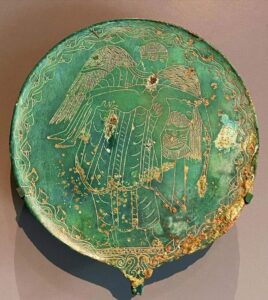Introduction: Etruria’s Legacy of Bronze Craftsmanship
The Etruscan civilization, which thrived in present-day Italy, was an influential force from the 9th to the 1st century BC. Known for their sophisticated artistry and impressive metalworking skills, the Etruscans created objects that not only served practical purposes but also embodied cultural and symbolic meanings. Among these artifacts, the Etruscan Bronze Hand Mirror (470-450 BC), found in southern Italy, stands out as an exquisite example of Etruscan metalwork. Housed at the MET Museum, this mirror reflects a civilization deeply engaged in trade, luxury, and the symbolism of everyday objects.
Etruscan Resources and Metallurgy: A Center of Tin and Copper
Etruria’s Metal-Rich Geography
Etruria, a region with abundant deposits of tin and copper, held a unique position in the ancient Mediterranean. These resources, essential for making bronze, attracted seafaring merchants and artisans from across the Mediterranean who sought the raw materials that were both rare and valuable in ancient times.
Etruscan Bronze Craftsmanship
Bronze, an alloy of tin and copper, was cherished for its durability, rich color, and suitability for detailed engraving. Etruscan metalsmiths perfected techniques of bronze casting, molding, and engraving to create objects ranging from mirrors and armor to votive statues and domestic tools. This level of craftsmanship made Etruscan bronze items highly prized throughout the Mediterranean.

The Etruscan Bronze Hand Mirror: Symbolism and Utility
Design and Symbolic Significance
The Etruscan Bronze Hand Mirror features intricate engravings, which would have held symbolic meaning in Etruscan culture. Mirrors in ancient societies often symbolized beauty, wisdom, and even mystical properties. In Etruria, mirrors like this could have represented more than mere vanity items; they were believed to serve as portals to spiritual reflection or protection.
The detailed engravings on these mirrors also reveal the Etruscan interest in mythological scenes, often depicting gods, heroes, or symbolic imagery that conveyed beauty and wisdom. Owning such an artifact was a mark of status, showing not only wealth but also cultural refinement.
Functionality and Craftsmanship
While decorative, these mirrors were also fully functional, polished to a smooth reflective surface using specialized techniques. Creating such mirrors involved a process of casting, engraving, and careful polishing, all by highly skilled artisans. The result was a polished surface with elegant designs, suggesting that each mirror was a personalized luxury item, created for a specific owner, likely an elite member of Etruscan society.

The Etruscan Trade Network: A Thriving Mediterranean Exchange
The Etruscans as Mediterranean Traders
Etruria’s strategic location and valuable resources allowed the Etruscans to establish strong trade connections across the Mediterranean. Their bronze items, especially mirrors, were sought-after luxury goods and became a staple of Etruscan exports. In return, they imported a variety of luxurious goods, including fine Athenian ceramics, ivory, and elaborate jewelry.
Exchange of Culture and Goods
Etruscan mirrors in particular became emblematic of Etruscan art and were traded widely, not only as functional items but also as cultural artifacts that reflected the tastes and values of Etruria’s elite. The influx of foreign luxury goods in exchange for Etruscan bronze contributed to a cultural exchange that blended local traditions with influences from Greek and Eastern cultures. This dynamic trade fostered a rich artistic culture in Etruria, which influenced their own artistic practices and enriched their symbolic representation in artifacts like the bronze mirror.

The Legacy of the Etruscan Bronze Hand Mirror
The Etruscan Bronze Hand Mirror at the MET is more than an ancient artifact; it is a piece of history that encapsulates the values, artistry, and intercultural connections of an ancient civilization. The Etruscans’ skill in metalworking, combined with their cultural exchanges across the Mediterranean, allowed them to create objects that were not only functional but also rich in symbolic meaning.
Conclusion: An Enduring Symbol of Etruscan Art and Influence
The Etruscan Bronze Hand Mirror remains a testament to the skilled craftsmanship, aesthetic sensibilities, and dynamic trade network of ancient Etruria. It provides modern audiences with a glimpse into the sophistication of a society that valued beauty, symbolism, and intercultural connections. For historians, collectors, and art enthusiasts alike, this mirror is an invaluable piece that bridges the ancient world with our understanding of art, status, and culture in Etruscan society.
